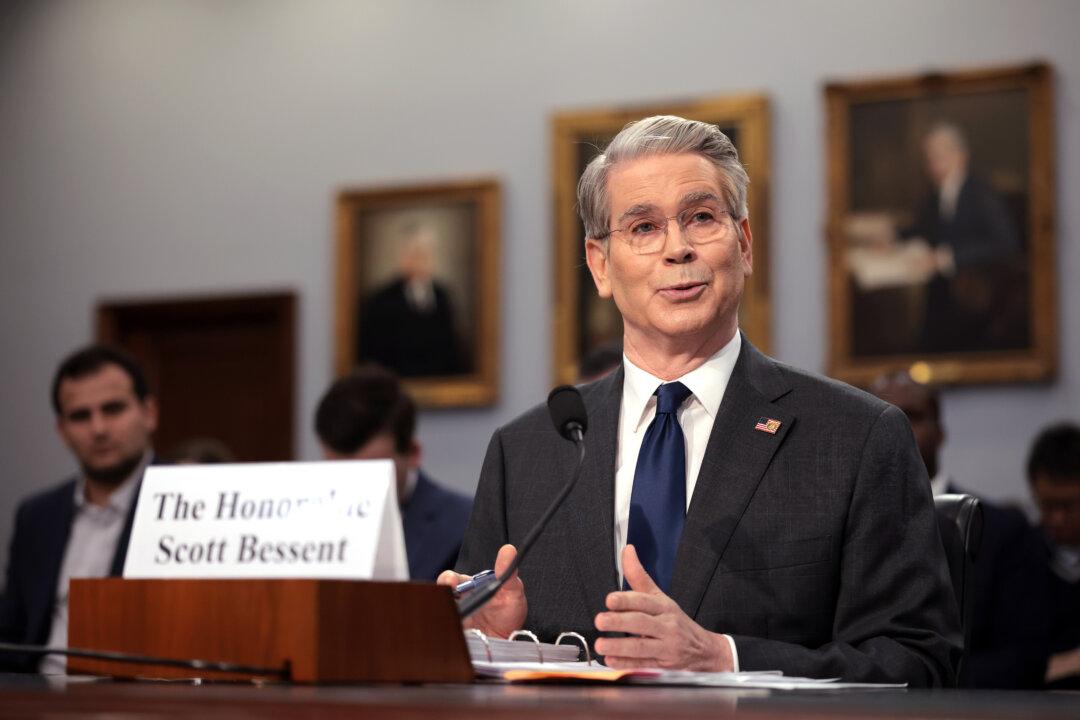President Donald Trump, on May 8, provided a broad overview of a prospective trade agreement with the United Kingdom.
The administration’s preliminary deal is the first by the United States since Trump announced his comprehensive April 2 tariff plans.
But while the president stopped short of offering the contours of the deal, he noted that the arrangement will bolster market access for U.S. exports as the United Kingdom will “reduce or eliminate numerous non-tariff barriers that unfairly discriminate against American products.”
Nothing was signed during the announcement.
“In the coming weeks, we’ll have it all very conclusive,” Trump told reporters at the Oval Office.
The UK tariff rate will also be lowered from 5.1 percent to 1.8 percent. The 10 percent U.S. universal baseline tariff rate on UK goods entering the country will remain in place.
Starmer, speaking at a Jaguar Land Rover facility in the UK’s West Midlands shortly after talking to Trump by phone, revealed more details of the trade agreement.
“This is just the start,” he said. “We are hammering out further details to reduce barriers to trade with the United States and across the world.”
As part of the new trade agreement, the United States will lower tariffs on UK automobiles from 27.5 percent to 10 percent and remove tariffs on steel and aluminum.
The pact will establish a quota of 100,000 UK vehicles that can be exported to the United States at a 10 percent levy.
“Because of our long time history and allegiance together, it is a great honor to have the United Kingdom as our first announcement,“ the president said. ”Many other deals, which are in serious stages of negotiation, to follow!”
The deal comes shortly after the Bank of England followed through on a quarter-point interest rate cut, lowering the policy rate to 4.25 percent.
Bank of England Gov. Andrew Bailey welcomed the trade deal, but stopped short of commenting further as he waited for more details.
“I say that because I hope the UK agreement, if it is the case this afternoon, will be the first of many,” he said at a press conference. “This will be good news all around, including the UK economy.”
Starmer Tact Succeeds
The deal is a win for the prime minister’s placatory approach to Trump’s tariff agenda.During the April 2 tariff announcement, Britain was not hit with reciprocal tariffs but faced a baseline 10 percent levy.
Unlike his European Union or Canadian counterparts, British Prime Minister Keir Starmer chose not to retaliate with tit-for-tat tariffs.
“We are continuing to talk to the U.S. about how further we can mitigate the impact of the tariffs,” Starmer said last month.
“But a trade war is in nobody’s interest, and there is no business sector that is being impacted by these tariffs who is saying jump in with both feet to retaliate and cause a trade war.”
Canada and the EU have implemented retaliatory levies on a host of U.S.-made products.
Both countries, meanwhile, have sought to establish a bilateral trade agreement since 2016, when the British people voted to leave the EU. While trade negotiations began in 2020, there was little progress under the previous administration.
Last year, total trade in goods and services between the United States and the UK was approximately $400 billion.
According to the U.S. Trade Representative’s Office, the United States registered a goods trade surplus of $11.9 billion in 2024, up more than 17 percent from the previous year.
The United States is far more critical to the UK economy, accounting for more than 16 percent of the nation’s trade—the EU is first at nearly 48 percent.
Starmer and his Labor government have been pursuing trade agreements with other foreign markets, including India.
Market Reaction
Investors cheered the prospect of the Trump administration inching closer to various trade deals that would curtail the growing uncertainty.The leading stock market benchmark averages rose, with the blue-chip Dow Jones Industrial Average picking up about 200 points. The tech-heavy Nasdaq Composite Index and the broader S&P 500 jumped by around 0.5 percent.
U.S. Treasury yields were mostly up across the board. The benchmark 10-year yield climbed to 4.3 percent
The U.S. dollar index—a gauge of the greenback against a weighted basket of currencies—rose by 0.3 percent and has pared its year-to-date decline to below 8 percent.
While Wall Street was attentive to the Federal Reserve’s May policy meeting fallout, markets will concentrate more on trade negotiations, according to Charlie Ashley, a portfolio manager at Catalyst Funds.
“Currently, the U.S. market is more at risk of deteriorating due to a trade policy mistake than it is of a Fed policy mistake,” Ashley said in a note emailed to The Epoch Times.
“Fed policy can certainly exacerbate a market move, but the outcomes of trade negotiations is what will be the main driver of market direction in the near-term.”
Monetary policymakers stated that economic activity remained robust, but signaled stagflation concerns as “the risks of higher unemployment and higher inflation have risen.”







